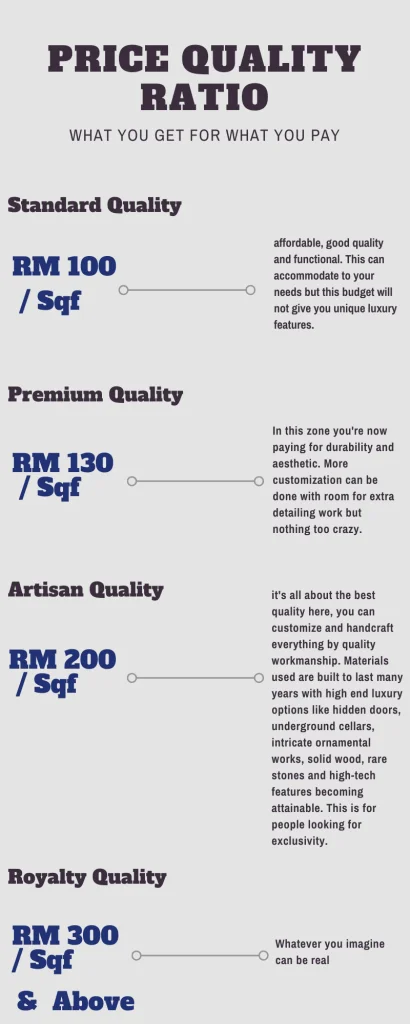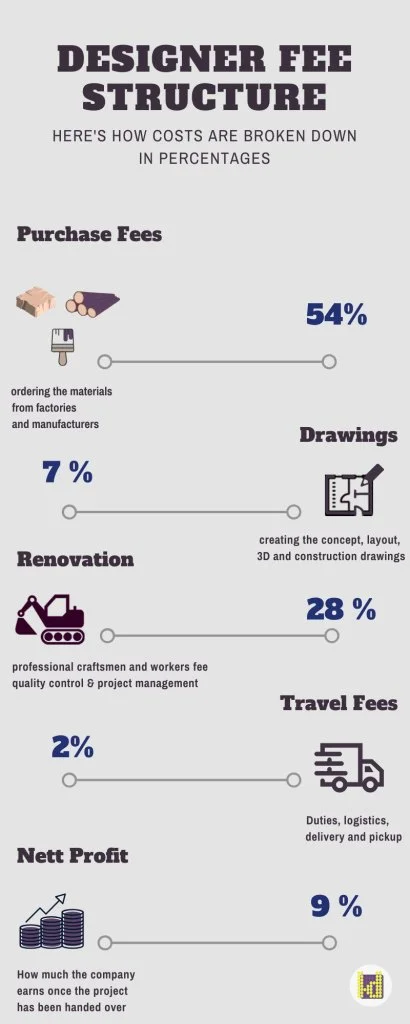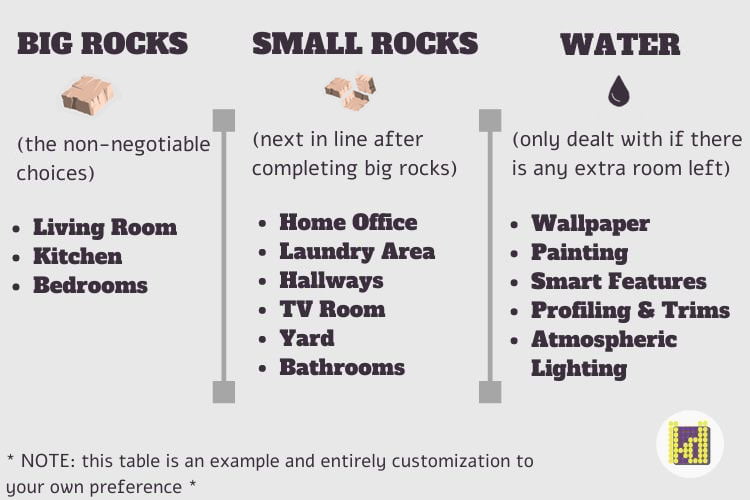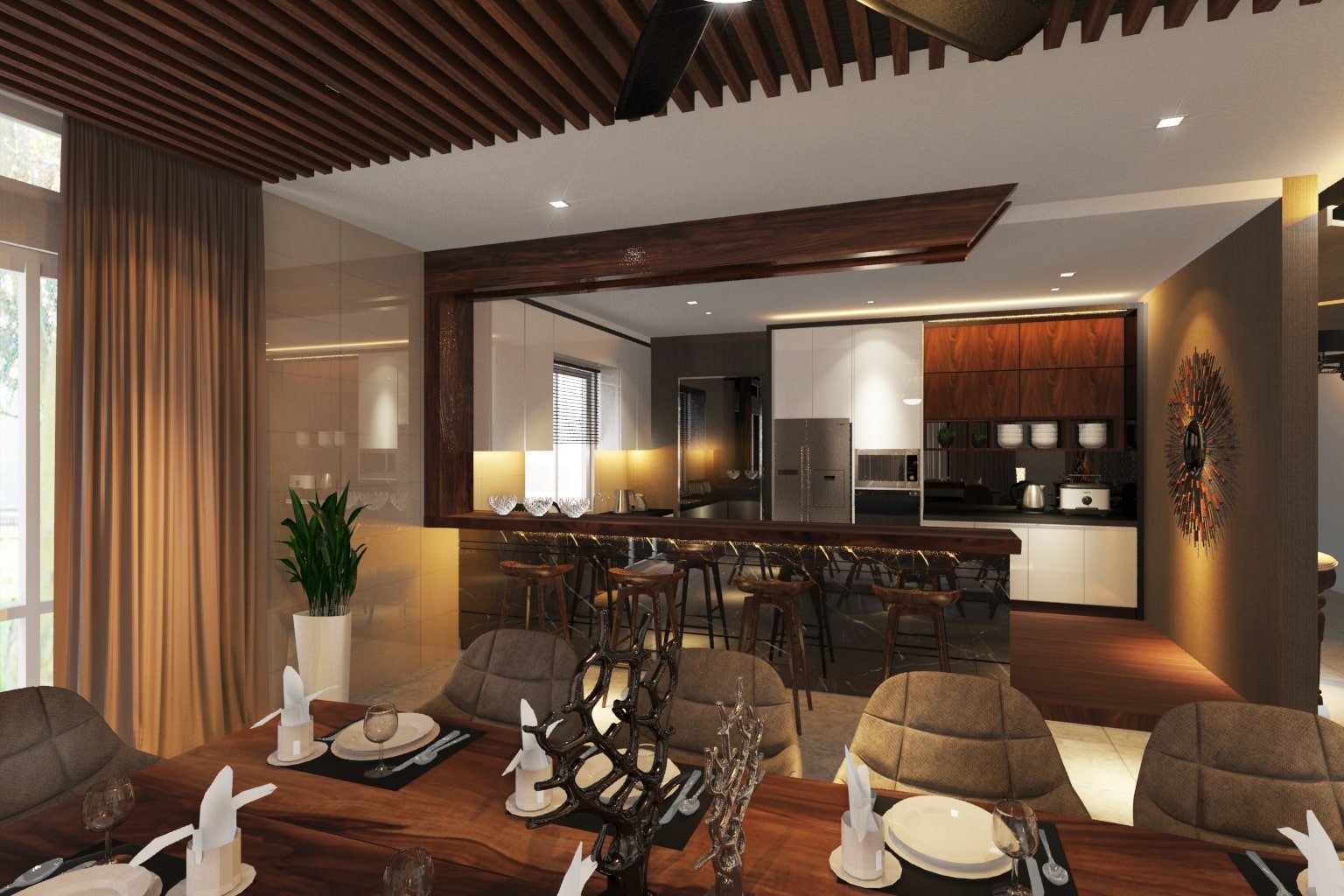There’s a lot of confusion and misconception out there when it comes to professional interior design and renovation pricing and how their service fees are applied.
With every professional designer, company and contractor having their own pricing structure and business model, it becomes frustrating to understand what the industry standard is when you’re surveying and filtering different providers.
On top of that, you also have to add in the fact that your property is unique to itself: from the size, existing site condition, your personal taste, your customization and the quality you’re expecting.
So as a customer, when everyone will be quoting you a different rate, how do you know who is the right provider that is not over charging you on the quality promised?
Our goal here is to eliminate all the confusion and provide you with a pricing structure that will explain to you how this industry is priced and what you should be looking at when it comes to quality to price ratio.
Having dealt with all kinds of carpenters, manufacturers and factories over the past 16 years, we’ve collected enough data to set a perimeter for the quality / price ratio you can expect within Malaysia.
This means you can more or less use this structure as a guideline to any company you approach.
But before we jump into the fees, lets tackle some of the popular misconceptions and frequently asked questions below:
1. What Are Your Rates?
When it comes to customized original interior services, there are no fixed rates.
The pricing is not calculated per square foot of your house. Perhaps companies that provide you with the same ready made built-in furniture, wallpaper and lights and can give you an average cost per square foot as they use a generic standard of material quality and layout concept and can provide a flat rate.
However, if your planning on getting custom designs tailored to your wants and the outfit of your home, the entire budget will be based on the site condition, existing features within the property as well as the choice of material, quality level of the material and amount of craftsmanship involved.
2. There’s More Than One Quality Tier

When it comes to picking quality materials, there are different levels of quality, from standard, premium, high-end to royalty. Use fashion brands for example: you can have Zara, Coach, Chanel and then there’s Hermes.
All of the brands above have good quality products, but you can’t really compare them to one another because each one is at a different grade and level of quality and price.
Much like how you can pick marble stone as a material but have different quality priced marble depending on its properties, place of origin, and texture of the stone. Since marble is a luxury stone, non of them are cheap, but each level comes at a different price.
For example:
– Calacatta Marble (one of the most expensive due to its rarity)
– Carrara Marble (found in abundance and is the most affordable)
So when it comes to comparing material prices from different providers, its best to identify what quality tier your looking at before drawing a conclusion on who is giving you the best price.
One provider might charge you x amount for a lower grade marble, while another provider might charge you higher for the same sqf of marble but is offering you a higher quality marble.
Usually price will be able to tell you the level of quality, but you need to be able to know at what quality tier you’re being quoted.
3. More Details = More Work

Take classical design for example, what makes it stand out from other styles of interior? It’s a lot more detail heavy, the ornamentation, profiling and time involved in making it is what gives the overall elegant feeling.
In addition to that, its a craft that’s not widely practiced nowadays, so the level of artisans and talent available that is experienced in this type of work is rare.
When picking an interior style, the level of craftsmanship that has to go into the project will raise the price. Makes sense right? More time, more work, more money to be paid to craftsmen. Hence, why Minimal design is usually the lowest cost as compared to classical or modern classic styles.
This also applies to construction and demolition. The more intensive work that needs to be done to your property, the more workers and materials and machines it will need. Which is why demolishing a wall, ripping your tiles, changing your toilet location will all require hacking / re-building / new structures / new permits / safety regulations and more rework which will all raise your total cost drastically as compared to built-in furniture and refurbishment work.
4. Why Are Contractors Cheaper?

You’re probably familiar with a situation where your contractor will charge you RM50 to add a plug point. Whereas an interior designer might charge you RM100 to add the same plug point.
Neither is better than the other, but rather each one is a fee for a different service. With the contractor, you’re paying for the job execution, but with the designer you’re getting an added service fee.
This means that they will not only make sure that the contractor gets it done in good condition, but also ensure that you’re satisfied with the job. If there’s a problem, the designer will have to ensure it gets fixed and manages the people in the project to get it done. Consider it an after sales service and extra satisfaction warranty. Whereas with a contractor, if something happens there’s no one to hold them eligible for the bad work.
One top of that, your designer fee is an all rounder fee that encompasses the entire project. Meaning they are your middle man from A-Z. Renovation is a tedious process that involves many different parties coming together under one project. Contractors, workers, material suppliers, manufacturers and electricians.
By having one person that you can liaise with, this makes it easier to get complaints settled, quality control and communication for the entire process without having to call each provider individually. This also ensures that your designer is communicating your project brief clearly to these parties and holds accountability for getting the job done at the quality and vision promised.
5. Why Is Furniture From Manufacturers Cheaper?

When it comes to designing your built in furniture, you’ll always find that its more expensive than any price tag you’ll get from furniture manufacturers. Why?
Because when it comes to manufacturers, they get the benefit of economy of scale since they are mass producing from modular units. This means that they are replicating the same piece of furniture with the specific dimensions that they can scale.
This means that if you have a specific size for your living room you’re limited to the dimensions offered by the manufactures which are based off a specific modular system. Not to mention they will use mixture of cheaper materials to drive the product cost down.
When it comes to customizing your interior design built-in furniture, you’re getting original carpentry work that’s exactly tailored to your properties needs and specifications. Not only does the price come with the customization but also the quality and solidity of the wood used. So if originality is what you’re going for, then interior customization is for you.
Price Per Quality Ratio
This is probably the most important part of understanding and being able to estimate your own renovation and interior design costs before approaching a professional.
As mentioned above there are plenty of material choices, level of material quality and the extensiveness of the work that will affect your total cost. So at the end of the day you would still need to inquire with a designer to get an accurate quotation based on site visits.
However, you can still apply this cost structure for getting an estimate to how much you can expect for the price to quality ratio for your project:

It’s also worth mentioning that you can always opt for mixing between these tiers.
Here’s an example of how you would apply this estimation to your project:
You want to renovate an entire 3000 sqf house, lets say that you’re a deep sleeper and have big dreams for your ultimate master bedroom and don’t want to hold back on quality.
But when it comes to your living room you’re not the type to spend time at home watching movies and can settle for more practical simpler features for your living room, you would do something like this:
– Artisan: Master Bedroom
(400 sqf x RM 200 = RM 80,000)
– Standard: Living Area
(300 sqf x RM 100 = RM 30,000)
– Premium: Remaining Bedrooms & Other Areas
(2300 sqf x RM 130 = RM 299,000
TOTAL ESTIMATED RENOVATION = RM 409,000
(NOTE: these costs are based off carpenters and manufacturers within Kuala Lumpur) if you live within the other Malaysian states, your local carpenters and manufacturers will charge a lower rate than service providers in the capital city.
Now the prices above applies to your general all rounder renovation works, for example:
– Built-in furniture (carpentry)
– Ceiling and lighting
– Walls
This does not include construction works for hacking, building new structures or ripping floors, plumbing etc. So it serves its purpose to get a ballpark price to manage expectations.
This also allows you to easily communicate to your designer the quality your going for so they can offer you suggestions based on your needs and customize to your budget.
But the price will definitely go up or down as you get more technical with the quotations. Perhaps you want to renovate your kitchen, but you only want to include the built-in furniture cabinets and don’t want to do anything for the walls or ceiling, then the price will go down and vice versa.
This framework however will definitely save you lots of time and headache as now you can clearly communicate to your designer how much you’d like to spend on each area of your property and how far you’d like to go.
Designer Pricing Structure
Now that we’ve covered how to calculate a general estimate for a customized project, you’re probably wondering how much of the total cost is going into the project and how much is going to the designers pocket.
If the company you’re dealing with is following fair practices the typical fee structure will look something like the chart below.
For Latitude Design at least, this is how we segment our fee structures:

So as you can probably tell that 91% of the renovation cost goes back into your project. After it’s all said and done, your interior designer will only make 9% – 12% of the service fee based on the scope of work.
This paints a totally different picture as to how this industry works and we hope that this piece of content was able to provide you with some clarity and ease some of the burden of renovation struggles.
Conclusion:

Now that you’ve got an idea of how to estimate your renovation costs and to what extent quality goes as to price. This still leaves you with the question of how to allocate your budget effectively when everything is customized to space size, level of quality and site conditions.
Below is a guideline I like to personally use when I need to make difficult life decisions where there are multiple variables involved. It just so happens that it’s also a great framework for renovation too:
1. You want to create a list with the following categories like the chart above:
– Big Rocks
– Small Rocks
– Water
2. Then decide on the areas that matter to you the most and how much of your personal budget you’d like to allocate to each of those areas by selecting one of the quality tiers.
3. Then from there decide on the style you want as this well affect the price too.
4. Lastly, find a trustworthy designer and share with them your preferences
Keep in mind that these strategies will only give you a general estimate. When it comes to customized interior and renovation works, it’s almost impossible to get a totally accurate quotation without having had the designer perform a site visit to your property.
This guideline is mainly meant to help you survey and filter the right design company for you a lot more easily.
Want to calculate interior design pricing in Malaysia? Use our renovation calculator below to get an estimate cost then submit your entry if you want to get a more personal estimate from our team!



Your article was interesting. This i would like to share as i am in the midst of renovating my Semi D. First i engaged my friend who disign the ID based on my ideas with her input from ID point of view.Then 3 sets of important contractors namely – wet work, plumbing & electrical were selected.I obtained 2 to 3 sets of quotations based on the same BQ. .After selection on these 3 main contractosrs..i then proceed to source my own materials from Bathroom /sanitaty wares/ tiles /laminated flooring/ air conds/pest control/alarm/CCTV/secirity mesh/glass/ autogate/kitchen cabinet/ Furniture & Fittings as well as kitchen appliances.i did not engage a site supervisor as i am there onsite everyday ( twice in a day )..i guess this is how it should be done if you want it to be done exactly what you have in mind and not letting the ID nor the contractors to do what they think you like eventhough plans are drawn up.learned a lot along the way..all costing is as close as i can get in comparison to my budget..Madam Low TTDI
Hello Madam Low, sorry for the late reply and thanks for sharing your story. Hope your project is going well!
Hi, I’d like get quotation for my new condo.
Hello Alicia,
Please check your email, we’ve sent you some questions!
Thanks
– Amr
need quotatikn
estimation sent! 😀
I’m looking for an ID to design my house. Looking forward for your reply. Thanks
Hello Mary Lim,
We’ve sent you an email to discuss more details 🙂
Hi, would like to know where does the authority submission for renovation fit in your designer fee structure ? And how many % to allocate?
Who would be involved for the submission?
Can the renovation commence while waiting for the submission approval?
Thanks.
Hello Vins! Renovation cannot commence while waiting for submission approval, we have sent you more details regarding the fees to your email 🙂
I am looking designer for my kitchen cabinet
Very informative article, especially the idea of setting different budget for different room/space, and the design fee structure seems fair too
I would like to get a quotation for my new condo.
Yes, that’s the beauty of going bespoke is the flexibility of the quality with the price. Glad you enjoyed our article and thanks for reaching out to us on the phone today!
looking forward to serving you 🙂